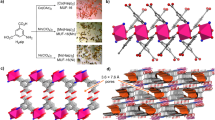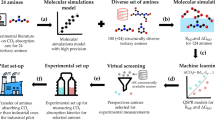Abstract
One of the main bottlenecks to deploying large-scale carbon dioxide capture and storage (CCS) in power plants is the energy required to separate the CO2 from flue gas. For example, near-term CCS technology applied to coal-fired power plants is projected to reduce the net output of the plant by some 30% and to increase the cost of electricity by 60–80%. Developing capture materials and processes that reduce the parasitic energy imposed by CCS is therefore an important area of research. We have developed a computational approach to rank adsorbents for their performance in CCS. Using this analysis, we have screened hundreds of thousands of zeolite and zeolitic imidazolate framework structures and identified many different structures that have the potential to reduce the parasitic energy of CCS by 30–40% compared with near-term technologies.
This is a preview of subscription content, access via your institution
Access options
Subscribe to this journal
Receive 12 print issues and online access
$259.00 per year
only $21.58 per issue
Buy this article
- Purchase on Springer Link
- Instant access to full article PDF
Prices may be subject to local taxes which are calculated during checkout







Similar content being viewed by others
References
Chu, S. Carbon capture and sequestration. Science 325, 1599 (2009).
Pacala, S. & Socolow, R. Stabilization wedges: Solving the climate problem for the next 50 years with current technologies. Science 305, 968–972 (2004).
Metz, B., Davidson, O., deConinck, H., Loos, M. & Meyer, L. IPCC Special Report on Carbon Dioxide Capture and Storage. (Intergovernmental Panel on Climate Change (IPCC), 2005); http://www.ipcc.ch.
Massood, R., Timothy, J. S., Nsakala ya, N. & Liljedahl, G. N. Carbon Dioxide Capture from Existing Coal-Fired Power Plants (National Energy Technology Laboratory, US Department of Energy, 2007).
Bhown, A. S. & Freeman, B. C. Analysis and status of post-combustion carbon dioxide capture technologies. Environ. Sci. Technol. 45, 8624–8632 (2011).
Bottoms, R. Separating acid gases. US Patent 1,783,901 (1930).
Rochelle, G. T. Amine scrubbing for CO2 capture. Science 325, 1652–1654 (2009).
Ciferno, J. P., Marano, J. J. & Munson, R. K. Technology integration challenges. Chem. Eng. Prog. 107, 34–44 (2011).
Ferey, G. Hybrid porous solids: Past, present, future. Chem. Soc. Rev. 37, 191–214 (2008).
Yaghi, O. M. et al. Recticular synthesis and the design of new materials. Nature 423, 708–714 (2003).
D’Alessandro, D. M., Smit, B. & Long, J. R. Carbon dioxide capture: Prospects for new materials. Angew. Chem. Int. Ed. 49, 6058–6082 (2010).
Banerjee, R. et al. High-throughput synthesis of zeolitic imidazolate frameworks and application to CO2 capture. Science 319, 939–943 (2008).
Deem, M. W., Pophale, R. & Cheeseman, P. A. A database of new zeolite-like materials. Phys. Chem. Chem. Phys. 13, 12407–12412 (2011).
Krishna, R. & van Baten, J. M. In silico screening of metal-organic frameworks in separation applications. Phys. Chem. Chem. Phys. 13, 10593–10616 (2011).
Krishna, R. & Long, J. R. Screening metal-organic frameworks by analysis of transient breakthrough of gas mixtures in a fixed bed adsorber. J. Phys. Chem. C 115, 12941–12950 (2011).
Yazaydin, A. O. et al. Screening of metal-organic frameworks for carbon dioxide capture from flue gas using a combined experimental and modeling approach. J. Am. Chem. Soc. 131, 18198 (2009).
Freeman, S. A., Dugas, R., Van Wagener, D., Nguyen, T. & Rochelle, G. T. Carbon dioxide capture with concentrated, aqueous piperazine. Energy Procedia 1, 1489–1496 (2009).
Lemmon, E. W., Huber, M. L. & McLinden, M. O. NIST Reference Fluid Thermodynamic and Transport Properties Database (REFPROP): Version 9.0. (NIST, 2010); http://www.nist.gov/srd/nist23.cfm.
Frenkel, D. & Smit, B. Understanding Molecular Simulations: From Algorithms to Applications 2nd edn (Academic, 2002).
Smit, B. & Maesen, T. L. M. Molecular simulations of zeolites: Adsorption, diffusion, and shape selectivity. Chem. Rev. 108, 4125–4184 (2008).
Krishna, R., Calero, S. & Smit, B. Investigation of entropy effects during sorption of mixtures of alkanes in MFI zeolite. Chem. Eng. J. 88, 81–94 (2002).
Myers, A. L. & Prausnitz, J. M. Thermodynamics of mixed gas adsorption. Am. Inst. Chem. Eng. J. 11, 121–130 (1965).
Rao, M. B. & Sircar, S. Thermodynamic consistency for binary gas adsorption equilibria. Langmuir 15, 7258–7267 (1999).
Martin, R. L., Smit, B. & Haranczyk, M. Addressing challenges of identifying geometrically diverse sets of crystalline porous materials. J. Chem. Inf. Modell. 52, 308–318 (2012).
Deem, M. W., Pophale, R., Cheeseman, P. A. & Earl, D. J. Computational discovery of new zeolite-like materials. J. Phys. Chem. C 113, 21353–21360 (2009).
Simancas, R. et al. Modular organic structure-directing agents for the synthesis of zeolites. Science 330, 1219–1222 (2010).
Jariwala, K. & Haranczyk, M. http://www.carboncapturematerials.org (2011).
International Zeolite Association (IZA); http://www.iza-structure.org/databases (2011).
Sanders, M. J., Leslie, M. & Catlow, C. R. A. Interatomic potentials for SiO2 . J. Chem. Soc. Chem. Commun. 1271–1273 (1984).
Beest, B. W. H. v., Kramer, G. J. & Santen, R. A. v. Force fields for silicas and aluminophosphates based on ab initio calculations. Phys. Rev. Lett. 64, 1955–1958 (1990).
Willems, T. F., Rycroft, C. H., Kazi, M., Meza, J. C. & Haranczyk, M. Algorithms and tools for high-throughput geometry-based analysis of crystalline porous materials. Micropor. Mesopor. Mater. 149, 134–141 (2012).
Garcia-Perez, E., Dubbeldam, D., Liu, B., Smit, B. & Calero, S. A computational method to characterize framework aluminum in aluminosilicates. Angew. Chem. Int. Ed. 46, 276–278 (2007).
Löwenstein, W. The distribution of aluminum in the tetrahedra of silicates and aluminates. Am. Miner. 39, 92–96 (1954).
Calero, S. et al. Understanding the role of sodium during adsorption. A force field for alkanes in sodium exchanged faujasites. J. Am. Chem. Soc. 126, 11377–11386 (2004).
Park, K. S. et al. Exceptional chemical and thermal stability of zeolitic imidazolate frameworks. Proc. Natl Acad. Sci. USA 103, 10186–10191 (2006).
Garcia-Perez, E. et al. A computational study of CO2, N2, and CH4 adsorption in zeolites. Adsorption-J. Int. Adsorption Soc. 13, 469–476 (2007).
Garcia-Sanchez, A. et al. Transferable force field for carbon dioxide adsorption in zeolites. J. Phys. Chem. C 113, 8814–8820 (2009).
Mayo, S. L., Olafson, B. D. & Goddard, W. A. DREIDING—a generic force-field for molecular simulations. J. Phys. Chem. 94, 8897–8909 (1990).
Siepmann, J. I. & Potoff, J. J. Vapor-liquid equilibria of mixtures containing alkanes, carbon dioxide, and nitrogen. Aiche J. 47, 1676–1682 (2001).
Zhong, C. L. & Xu, Q. A general approach for estimating framework charges in metal-organic frameworks. J. Phys. Chem. C 114, 5035–5042 (2010).
Kim, J., Rodgers, J. M., Athenes, M. & Smit, B. Molecular Monte Carlo simulations using graphics processing units: To waste recycle or not? J. Chem. Theor. Comput. 7, 3208–3222 (2011).
Bates, S. P., Well, W. J. M. v., Santen, R. A. v. & Smit, B. Energetics of n-alkanes in zeolites: A configurational-bias Monte Carlo investigation into pore size dependence. J. Am. Chem. Soc. 118, 6753–6759 (1996).
Haranczyk, M. & Sethian, J. A. Navigating molecular worms inside chemical labyrinths. Proc. Natl Acad. Sci. USA 106, 21472–21477 (2009).
Haranczyk, M. & Sethian, J. A. Automatic structure analysis in high-throughput characterization of porous materials. J. Chem. Theor. Comput. 6, 3472–3480 (2010).
Acknowledgements
The research was supported by the US Department of Energy under contracts DE-AC02-05CH11231, #CSNEW918, DE-SC0001015, DE-FG02-03ER15456, ARPA-e, and CCSI and the Office of Innovation at the Electric Power Research Institute (a detailed description can be found in the Supplementary Information).
Author information
Authors and Affiliations
Contributions
All authors contributed significantly to the work presented in this paper.
Corresponding authors
Ethics declarations
Competing interests
The authors declare no competing financial interests.
Supplementary information
Supplementary Information
Supplementary Information (PDF 1640 kb)
Supplementary Information
Supplementary Information (AVI 113079 kb)
Rights and permissions
About this article
Cite this article
Lin, LC., Berger, A., Martin, R. et al. In silico screening of carbon-capture materials. Nature Mater 11, 633–641 (2012). https://doi.org/10.1038/nmat3336
Received:
Accepted:
Published:
Issue Date:
DOI: https://doi.org/10.1038/nmat3336
This article is cited by
-
CRAFTED: An exploratory database of simulated adsorption isotherms of metal-organic frameworks
Scientific Data (2023)
-
Electronic structural and lattice thermodynamic properties of MAlO2 and M5AlO4 (M = Li, Na, K) sorbents for CO2 capture applications
Discover Chemical Engineering (2023)
-
Research progress and perspectives on carbon capture, utilization, and storage (CCUS) technologies in China and the USA: a bibliometric analysis
Environmental Science and Pollution Research (2023)
-
Computational screening methodology identifies effective solvents for CO2 capture
Communications Chemistry (2022)
-
High-throughput Screening of Aluminophosphate Zeolites for Adsorption Heat Pump Applications
Chemical Research in Chinese Universities (2022)



